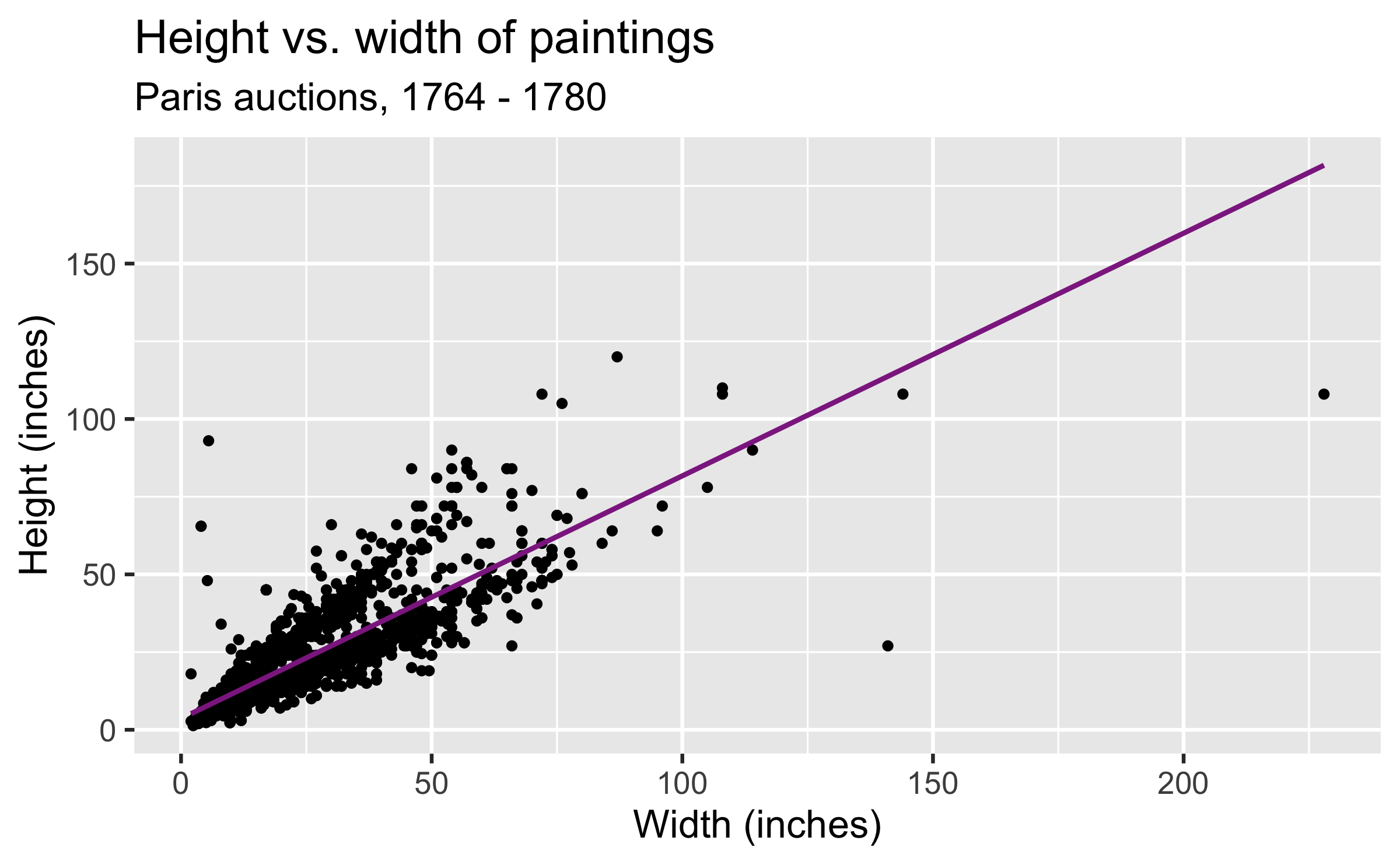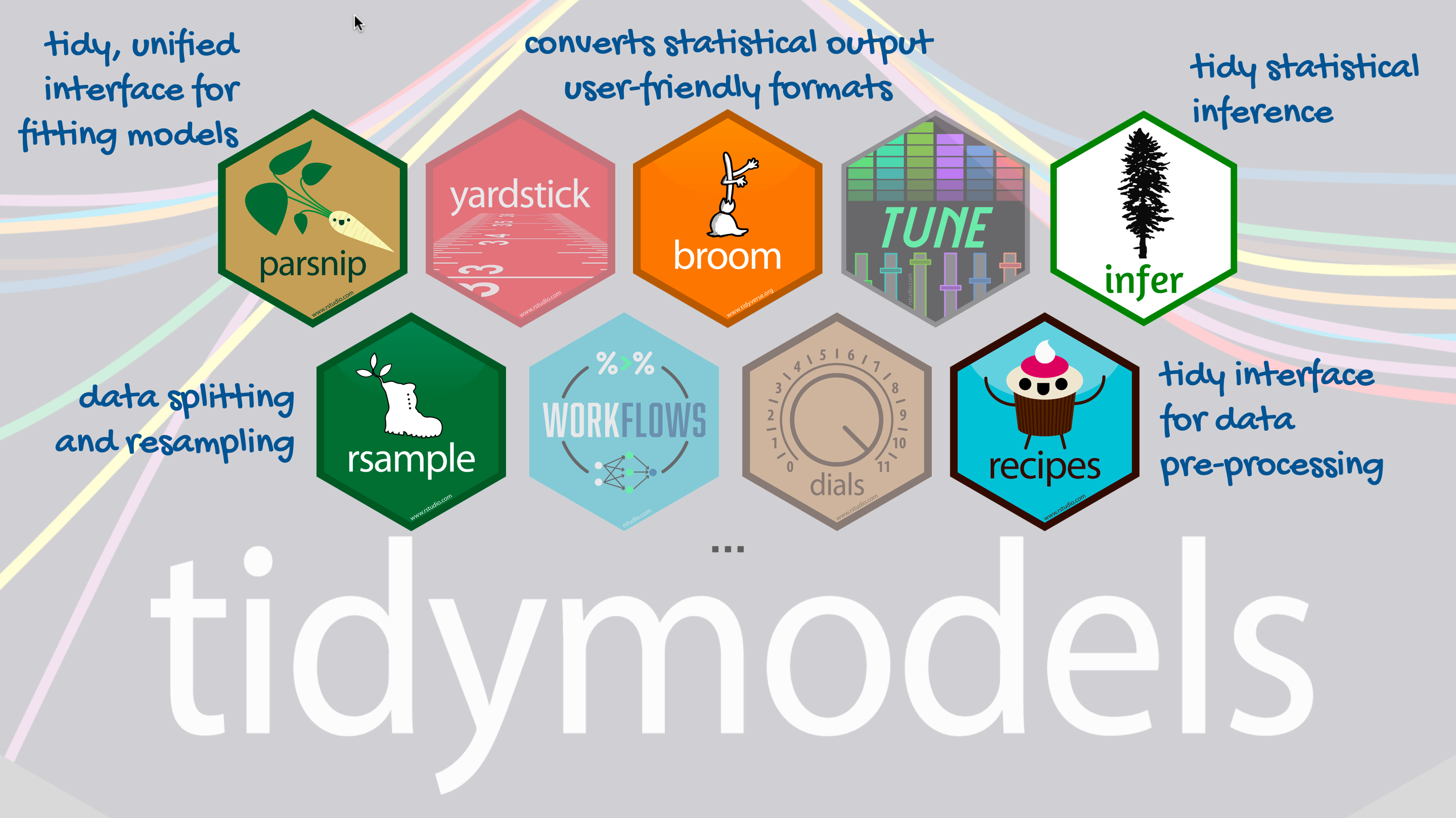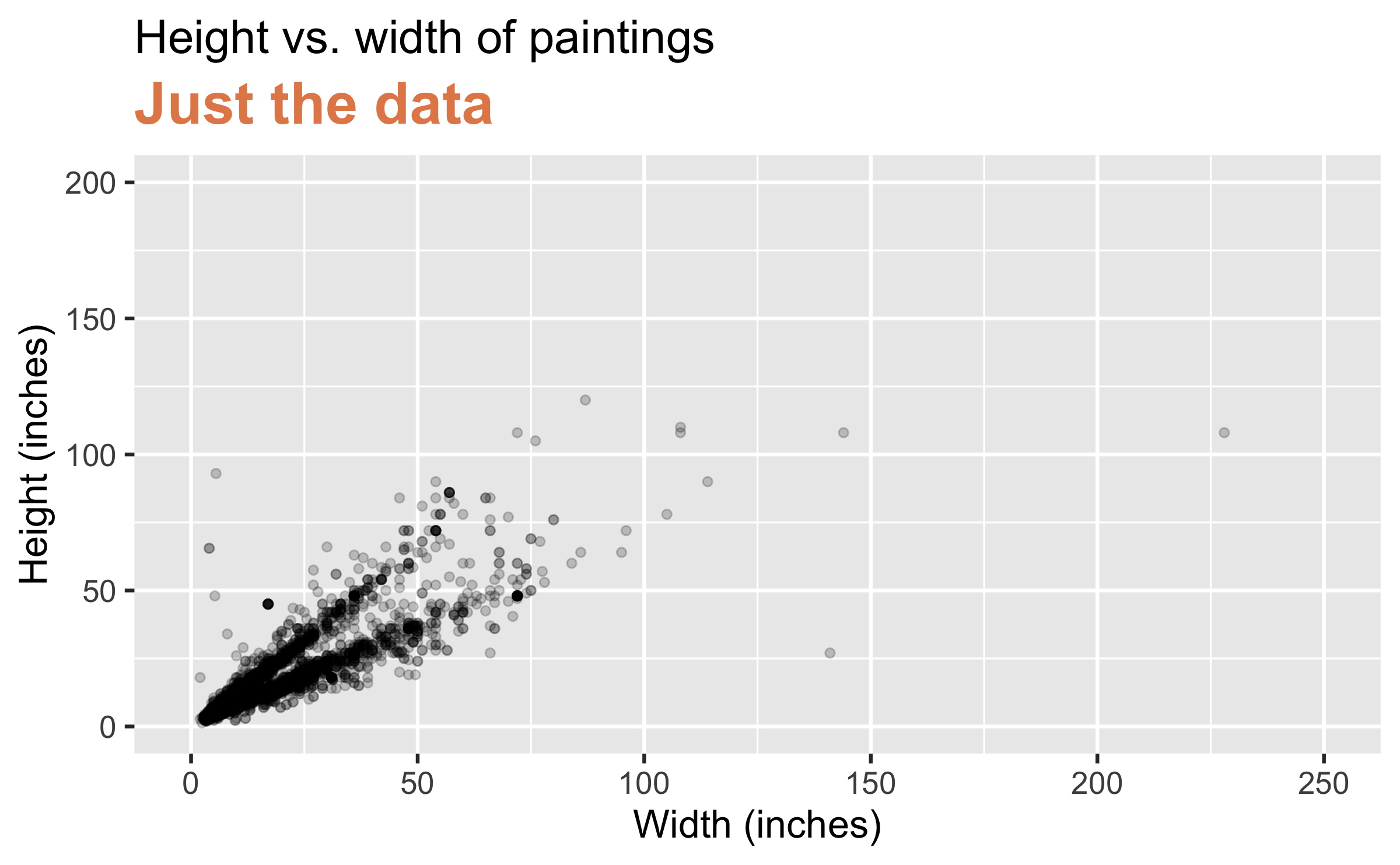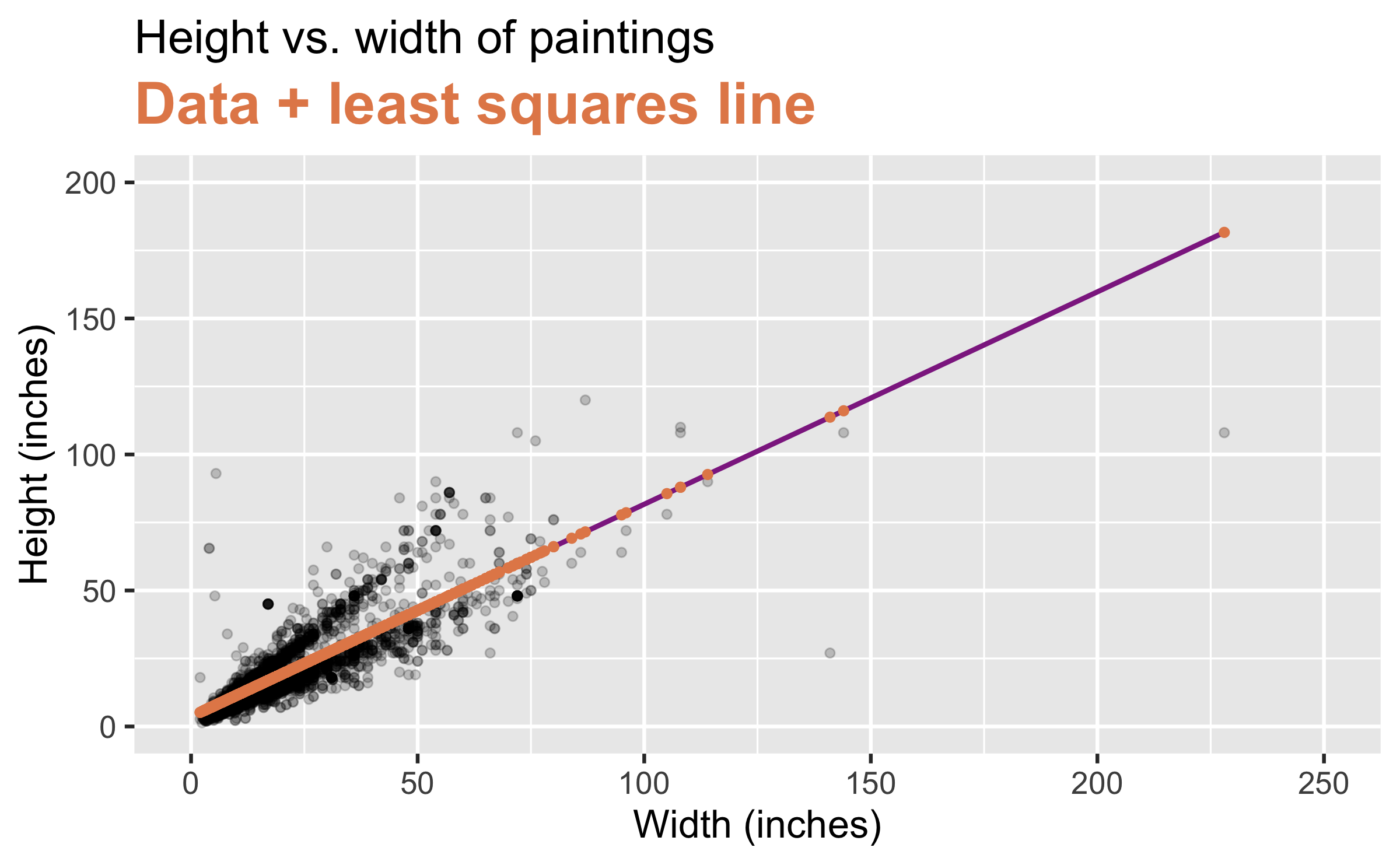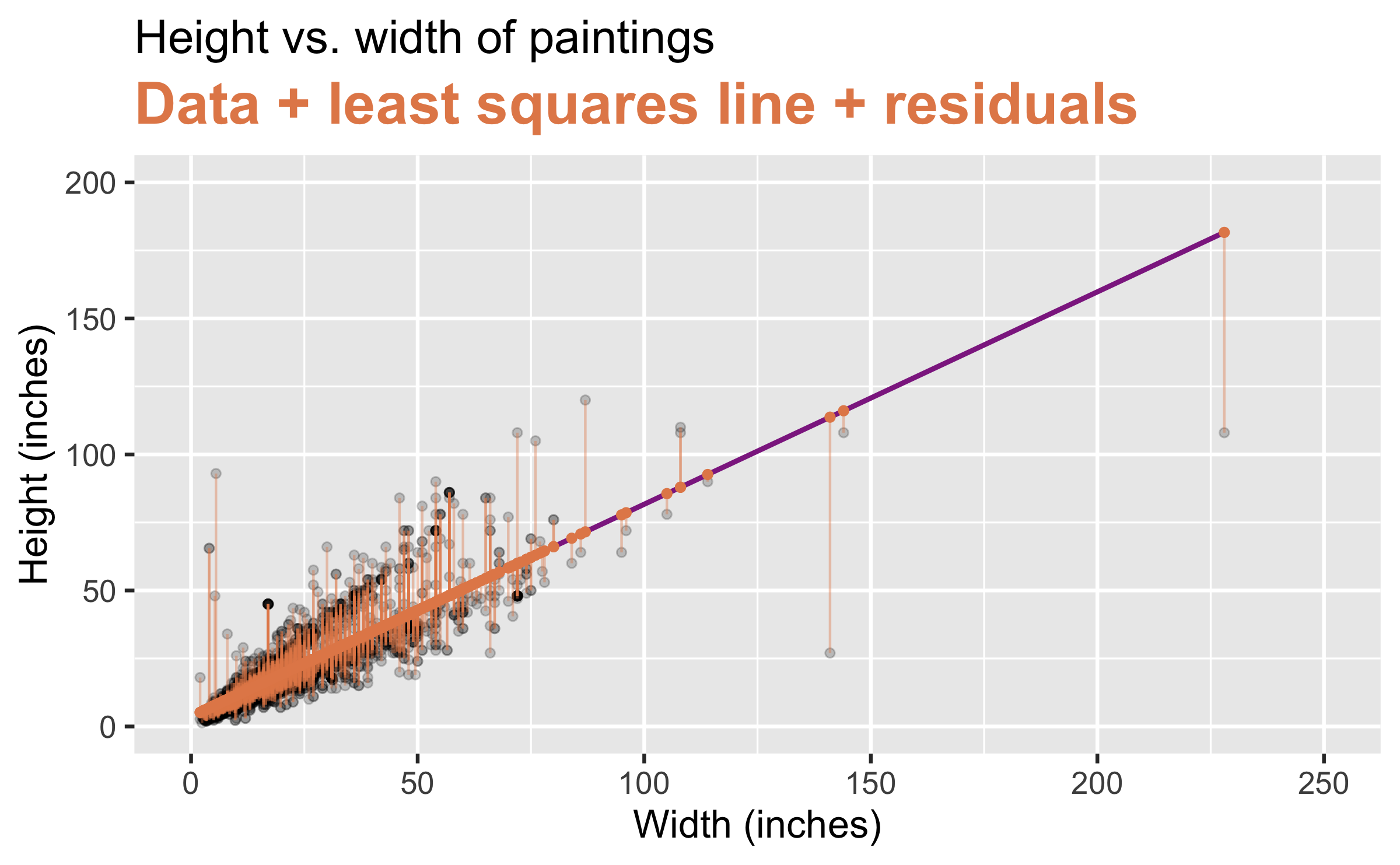Data: Paris Paintings
pp <- read_csv("data/paris-paintings.csv", na = c("n/a", "", "NA"))- Number of observations: 3393
- Number of variables: 61
3 / 27
Step 1: Specify model
linear_reg()## Linear Regression Model Specification (regression)## ## Computational engine: lm6 / 27
Step 2: Set model fitting engine
linear_reg() %>% set_engine("lm") # lm: linear model## Linear Regression Model Specification (regression)## ## Computational engine: lm7 / 27
Step 3: Fit model & estimate parameters
... using formula syntax
linear_reg() %>% set_engine("lm") %>% fit(Height_in ~ Width_in, data = pp)## parsnip model object## ## ## Call:## stats::lm(formula = Height_in ~ Width_in, data = data)## ## Coefficients:## (Intercept) Width_in ## 3.6214 0.78088 / 27
A closer look at model output
## parsnip model object## ## ## Call:## stats::lm(formula = Height_in ~ Width_in, data = data)## ## Coefficients:## (Intercept) Width_in ## 3.6214 0.7808ˆheighti=3.6214+0.7808×widthi
9 / 27
A tidy look at model output
linear_reg() %>% set_engine("lm") %>% fit(Height_in ~ Width_in, data = pp) %>% tidy()## # A tibble: 2 × 5## term estimate std.error statistic p.value## <chr> <dbl> <dbl> <dbl> <dbl>## 1 (Intercept) 3.62 0.254 14.3 8.82e-45## 2 Width_in 0.781 0.00950 82.1 0ˆheighti=3.62+0.781×widthi
10 / 27
Slope and intercept
ˆheighti=3.62+0.781×widthi
- Slope: For each additional inch the painting is wider, the height is expected to be higher, on average, by 0.781 inches.
11 / 27
Slope and intercept
ˆheighti=3.62+0.781×widthi
- Slope: For each additional inch the painting is wider, the height is expected to be higher, on average, by 0.781 inches.
- Intercept: Paintings that are 0 inches wide are expected to be 3.62 inches high, on average. (Does this make sense?)
11 / 27
Correlation does not imply causation
Remember this when interpreting model coefficients

Source: XKCD, Cell phones
12 / 27
Linear model with a single predictor
- We're interested in β0 (population parameter for the intercept) and β1 (population parameter for the slope) in the following model:
^yi=β0+β1 xi
14 / 27
Linear model with a single predictor
- We're interested in β0 (population parameter for the intercept) and β1 (population parameter for the slope) in the following model:
^yi=β0+β1 xi
- Tough luck, you can't have them...
14 / 27
Linear model with a single predictor
- We're interested in β0 (population parameter for the intercept) and β1 (population parameter for the slope) in the following model:
^yi=β0+β1 xi
- Tough luck, you can't have them...
- So we use sample statistics to estimate them:
^yi=b0+b1 xi
14 / 27
Least squares regression
- The regression line minimizes the sum of squared residuals.
15 / 27
Least squares regression
- The regression line minimizes the sum of squared residuals.
- If ei=yi−^yi, then, the regression line minimizes ∑ni=1e2i.
15 / 27
Properties of least squares regression
- The regression line goes through the center of mass point, the coordinates corresponding to average x and average y, (¯x,¯y):
¯y=b0+b1¯x → b0=¯y−b1¯x
19 / 27
Properties of least squares regression
- The regression line goes through the center of mass point, the coordinates corresponding to average x and average y, (¯x,¯y):
¯y=b0+b1¯x → b0=¯y−b1¯x
- The slope has the same sign as the correlation coefficient: b1=rsysx
19 / 27
Properties of least squares regression
- The regression line goes through the center of mass point, the coordinates corresponding to average x and average y, (¯x,¯y):
¯y=b0+b1¯x → b0=¯y−b1¯x
- The slope has the same sign as the correlation coefficient: b1=rsysx
- The sum of the residuals is zero: ∑ni=1ei=0
19 / 27
Properties of least squares regression
- The regression line goes through the center of mass point, the coordinates corresponding to average x and average y, (¯x,¯y):
¯y=b0+b1¯x → b0=¯y−b1¯x
- The slope has the same sign as the correlation coefficient: b1=rsysx
- The sum of the residuals is zero: ∑ni=1ei=0
- The residuals and x values are uncorrelated
19 / 27
Categorical predictor with 2 levels
## # A tibble: 3,393 × 3## name Height_in landsALL## <chr> <dbl> <dbl>## 1 L1764-2 37 0## 2 L1764-3 18 0## 3 L1764-4 13 1## 4 L1764-5a 14 1## 5 L1764-5b 14 1## 6 L1764-6 7 0## 7 L1764-7a 6 0## 8 L1764-7b 6 0## 9 L1764-8 15 0## 10 L1764-9a 9 0## 11 L1764-9b 9 0## 12 L1764-10a 16 1## 13 L1764-10b 16 1## 14 L1764-10c 16 1## 15 L1764-11 20 0## 16 L1764-12a 14 1## 17 L1764-12b 14 1## 18 L1764-13a 15 1## 19 L1764-13b 15 1## 20 L1764-14 37 0## # … with 3,373 more rowslandsALL = 0: No landscape featureslandsALL = 1: Some landscape features
21 / 27
Height & landscape features
linear_reg() %>% set_engine("lm") %>% fit(Height_in ~ factor(landsALL), data = pp) %>% tidy()## # A tibble: 2 × 5## term estimate std.error statistic p.value## <chr> <dbl> <dbl> <dbl> <dbl>## 1 (Intercept) 22.7 0.328 69.1 0 ## 2 factor(landsALL)1 -5.65 0.532 -10.6 7.97e-2622 / 27
Height & landscape features
ˆHeightin=22.7−5.645 landsALL
Slope: Paintings with landscape features are expected, on average, to be 5.645 inches shorter than paintings that without landscape features
- Compares baseline level (
landsALL = 0) to the other level (landsALL = 1)
- Compares baseline level (
Intercept: Paintings that don't have landscape features are expected, on average, to be 22.7 inches tall
23 / 27
Relationship between height and school
linear_reg() %>% set_engine("lm") %>% fit(Height_in ~ school_pntg, data = pp) %>% tidy()## # A tibble: 7 × 5## term estimate std.error statistic p.value## <chr> <dbl> <dbl> <dbl> <dbl>## 1 (Intercept) 14.0 10.0 1.40 0.162 ## 2 school_pntgD/FL 2.33 10.0 0.232 0.816 ## 3 school_pntgF 10.2 10.0 1.02 0.309 ## 4 school_pntgG 1.65 11.9 0.139 0.889 ## 5 school_pntgI 10.3 10.0 1.02 0.306 ## 6 school_pntgS 30.4 11.4 2.68 0.00744## 7 school_pntgX 2.87 10.3 0.279 0.78024 / 27
Dummy variables
## # A tibble: 7 × 5## term estimate std.error statistic p.value## <chr> <dbl> <dbl> <dbl> <dbl>## 1 (Intercept) 14.0 10.0 1.40 0.162 ## 2 school_pntgD/FL 2.33 10.0 0.232 0.816 ## 3 school_pntgF 10.2 10.0 1.02 0.309 ## 4 school_pntgG 1.65 11.9 0.139 0.889 ## 5 school_pntgI 10.3 10.0 1.02 0.306 ## 6 school_pntgS 30.4 11.4 2.68 0.00744## 7 school_pntgX 2.87 10.3 0.279 0.780- When the categorical explanatory variable has many levels, they're encoded to dummy variables
- Each coefficient describes the expected difference between heights in that particular school compared to the baseline level
25 / 27
Categorical predictor with 3+ levels
| school_pntg | D_FL | F | G | I | S | X |
|---|---|---|---|---|---|---|
| A | 0 | 0 | 0 | 0 | 0 | 0 |
| D/FL | 1 | 0 | 0 | 0 | 0 | 0 |
| F | 0 | 1 | 0 | 0 | 0 | 0 |
| G | 0 | 0 | 1 | 0 | 0 | 0 |
| I | 0 | 0 | 0 | 1 | 0 | 0 |
| S | 0 | 0 | 0 | 0 | 1 | 0 |
| X | 0 | 0 | 0 | 0 | 0 | 1 |
## # A tibble: 3,393 × 3## name Height_in school_pntg## <chr> <dbl> <chr> ## 1 L1764-2 37 F ## 2 L1764-3 18 I ## 3 L1764-4 13 D/FL ## 4 L1764-5a 14 F ## 5 L1764-5b 14 F ## 6 L1764-6 7 I ## 7 L1764-7a 6 F ## 8 L1764-7b 6 F ## 9 L1764-8 15 I ## 10 L1764-9a 9 D/FL ## 11 L1764-9b 9 D/FL ## 12 L1764-10a 16 X ## 13 L1764-10b 16 X ## 14 L1764-10c 16 X ## 15 L1764-11 20 D/FL ## 16 L1764-12a 14 D/FL ## 17 L1764-12b 14 D/FL ## 18 L1764-13a 15 D/FL ## 19 L1764-13b 15 D/FL ## 20 L1764-14 37 F ## # … with 3,373 more rows26 / 27
Relationship between height and school
## # A tibble: 7 × 5## term estimate std.error statistic p.value## <chr> <dbl> <dbl> <dbl> <dbl>## 1 (Intercept) 14.0 10.0 1.40 0.162 ## 2 school_pntgD/FL 2.33 10.0 0.232 0.816 ## 3 school_pntgF 10.2 10.0 1.02 0.309 ## 4 school_pntgG 1.65 11.9 0.139 0.889 ## 5 school_pntgI 10.3 10.0 1.02 0.306 ## 6 school_pntgS 30.4 11.4 2.68 0.00744## 7 school_pntgX 2.87 10.3 0.279 0.780- Austrian school (A) paintings are expected, on average, to be 14 inches tall.
- Dutch/Flemish school (D/FL) paintings are expected, on average, to be 2.33 inches taller than Austrian school paintings.
- French school (F) paintings are expected, on average, to be 10.2 inches taller than Austrian school paintings.
- German school (G) paintings are expected, on average, to be 1.65 inches taller than Austrian school paintings.
- Italian school (I) paintings are expected, on average, to be 10.3 inches taller than Austrian school paintings.
- Spanish school (S) paintings are expected, on average, to be 30.4 inches taller than Austrian school paintings.
- Paintings whose school is unknown (X) are expected, on average, to be 2.87 inches taller than Austrian school paintings.
27 / 27
